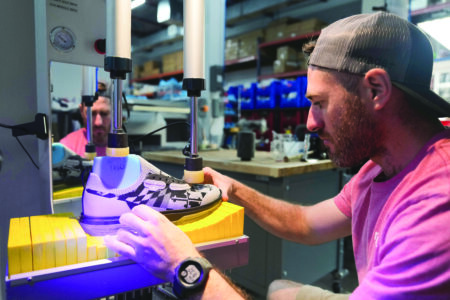Training the teachers
Educators undergo mental health curriculum instruction

Deb and Will Binion of The Jordan Project provide teacher training of the Mental Health & High School Curriculum. Local teachers took part in the event, which took place at the Marquette-Alger Regional Educational Service Agency. (Journal photo by Christie Bleck)
MARQUETTE — A teacher’s plate can be pretty full on any given school day, with math, science and other lessons packed in a limited time period.
However, it’s important a subject as serious as mental health be part of the curricula.
Teachers from across the Upper Peninsula underwent training on Thursday at the Marquette-Alger Regional Educational Service Agency to use the Mental Health & High School Curriculum, developed by Stan Kutcher, professor of psychiatry at Dalhousie University in Nova Scotia. The purpose of the curriculum is to help students better understand mental health and its related issues and illnesses.
Leading the training were Deb and Will Binion of Washington state, cofounders of the Jordan Binion Project, which partnered with the Mental Health & High School Curriculum to bring it to the Marquette area.
The mission of the Jordan Binion Project is to bring awareness of mental health through education.
“We truly believe that mental health literacy has the potential to save lives,” Deb Binion said.
Their son Jordan died by suicide while a senior in high school as a direct result of developing a mental illness.
What could have been done differently to prevent the tragedy?
“We just kept coming back to education,” she said.
Another thought went through their minds — that Jordan should have been given a sense of hope. She said effective treatments are available, and their son’s life was not necessarily over just because he was diagnosed with a mental illness.
“We knew that we couldn’t bring back our son, but we wanted to do whatever we could to prevent further tragedies like ours from occurring,” Deb Binion said.
They noticed a dearth of mental illness education.
“A lot of people are impacted by it yet we’re not talking about it in our school system,” she said.
They realized educating teachers on the topic was the answer.
So, they focused on the Mental Health & High School Curriculum.
This curriculum has six modules, which are detailed in a 166-page guide:
≤ The Stigma of Mental Illness.
≤ Understanding Mental Health and Mental Illness.
≤ Information on Specific Mental Illnesses.
≤ Experiences of Mental Illness and the Importance of Family Communication.
≤ Seeking Help and Finding Support.
≤ The Importance of Positive Mental Health.
In the Seeking Help module, for example, students engage in a problem-solving lesson in which they speculate about the possible actions they could take in a range of situations involving young people in distress.
“The beauty of this curriculum is that you can just pick up this guide, go into your classroom and begin teaching it,” Deb Binion said.
Dealing with mental health illness involves overcoming a major obstacle.
“Stigma is the No. 1 barrier to individuals seeking treatment for a mental health issue, and people that live with mental health issues basically say that dealing with the stigma is worse than dealing with the illness itself,” she said, pointing out that’s why the curriculum’s first module focuses on stigma.
Myths contribute to that stigma.
Deb Binion stressed a mental illness is a disturbance in brain function and is believed to be caused by a complex interplay between genetics and the environment — not witchcraft, demons or even just stress.
“The definition of mental health is having the capacity to successfully adapt to the challenges that life will offer us, and life will present us with some challenges,” Will Binion said.
Counseling and medication, or a combination of the two, are treatments used for people with mental disorders, which he noted differ from mental distress and health problems.
One exercise involved the teachers taking cards with various words and putting them on a triangle on a wall, with that triangle containing four levels from top to bottom: mental illness, mental problem, mental distress and no problem or distress.
They placed cards they picked on what they believed were the appropriate levels. For example, the mental illness category had cards labeled “bipolar” and “anxiety disorder,” while the mental problem level had “demoralized” and “terrified.”
Cards on the mental distress level included “on edge,” “upset” and “sorry,” while “excited” and “valued” were put into the lowest level of having no problem or distress.
One educator who attended the training believes students need to understand teachers will support them when it comes to mental health.
“I think it’s a really great thing that teachers in the area are focusing on teaching mental health and that students are being given a curriculum that is relatable to them, that is comprehensive,” said Beth Bertucci, who teaches high school English and Spanish as well as elementary/middle school Spanish at North Star Montessori Academy. “They can understand it and they can relate to it, which is what they need.
“They need to hear that we’re listening, that there are resources available to them.”
The free training was made possible by a $6,000 grant the Great Lakes Recovery Centers Inc., received from the Superior Health Foundation to train teachers in the curriculum. An additional $2,000 was received from the Do It For Daniel Foundation so stipends could be offered to help cover substitute teacher pay and mileage.
The foundation is named for Daniel Olson, an all-state quarterback for the Ishpeming High School football team who ended his life in 2012 after a lifelong battle with depression and anxiety.
For more information on the Mental Health and High School Curriculum guide, visit teenmentalhealth.org.





